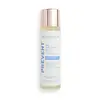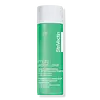What's inside
What's inside
 Key Ingredients
Key Ingredients

 Benefits
Benefits

 Concerns
Concerns

 Ingredients Side-by-side
Ingredients Side-by-side

Water
Skin ConditioningButylene Glycol
HumectantPolysorbate 20
EmulsifyingHamamelis Virginiana Water
AstringentPropanediol
SolventSalicylic Acid
MaskingPoloxamer 184
EmulsifyingBenzyl Alcohol
PerfumingCocamidopropyl Betaine
CleansingGlycerin
HumectantSodium Chloride
MaskingSodium Hydroxide
BufferingSodium Cocoamphoacetate
CleansingDisodium Cocoamphodiacetate
CleansingUrea
BufferingDehydroacetic Acid
PreservativeDisodium EDTA
Althaea Officinalis Root Extract
Skin ConditioningPhenoxyethanol
PreservativeAloe Barbadensis Leaf Juice
Skin ConditioningSodium Benzoate
MaskingPotassium Sorbate
PreservativeWater, Butylene Glycol, Polysorbate 20, Hamamelis Virginiana Water, Propanediol, Salicylic Acid, Poloxamer 184, Benzyl Alcohol, Cocamidopropyl Betaine, Glycerin, Sodium Chloride, Sodium Hydroxide, Sodium Cocoamphoacetate, Disodium Cocoamphodiacetate, Urea, Dehydroacetic Acid, Disodium EDTA, Althaea Officinalis Root Extract, Phenoxyethanol, Aloe Barbadensis Leaf Juice, Sodium Benzoate, Potassium Sorbate
Water
Skin ConditioningPropanediol
SolventAlcohol Denat.
AntimicrobialCaprylyl/Capryl Glucoside
CleansingAcetyl Glucosamine
Skin ConditioningDimethyl Isosorbide
SolventEthoxydiglycol
HumectantSuccinic Acid
BufferingButylene Glycol
HumectantSodium Hydroxide
BufferingSalicylic Acid
MaskingAllantoin
Skin ConditioningParfum
MaskingSodium Benzoate
MaskingPotassium Sorbate
PreservativeMyristyl Nicotinate
Skin ConditioningTranexamic Acid
AstringentPhytic Acid
Xylitol
HumectantCaprylic Acid
CleansingSodium Carbonate
BufferingSodium Chloride
MaskingT-Butyl Alcohol
PerfumingPolyglutamic Acid
Skin ConditioningDextran
Tripeptide-1
Skin ConditioningDenatonium Benzoate
MaskingLinalool
PerfumingGeraniol
PerfumingBenzyl Salicylate
PerfumingWater, Propanediol, Alcohol Denat., Caprylyl/Capryl Glucoside, Acetyl Glucosamine, Dimethyl Isosorbide, Ethoxydiglycol, Succinic Acid, Butylene Glycol, Sodium Hydroxide, Salicylic Acid, Allantoin, Parfum, Sodium Benzoate, Potassium Sorbate, Myristyl Nicotinate, Tranexamic Acid, Phytic Acid, Xylitol, Caprylic Acid, Sodium Carbonate, Sodium Chloride, T-Butyl Alcohol, Polyglutamic Acid, Dextran, Tripeptide-1, Denatonium Benzoate, Linalool, Geraniol, Benzyl Salicylate
Ingredients Explained
These ingredients are found in both products.
Ingredients higher up in an ingredient list are typically present in a larger amount.
Butylene Glycol (or BG) is used within cosmetic products for a few different reasons:
Overall, Butylene Glycol is a safe and well-rounded ingredient that works well with other ingredients.
Though this ingredient works well with most skin types, some people with sensitive skin may experience a reaction such as allergic rashes, closed comedones, or itchiness.
Learn more about Butylene GlycolPotassium Sorbate is a preservative used to prevent yeast and mold in products. It is commonly found in both cosmetic and food products.
This ingredient comes from potassium salt derived from sorbic acid. Sorbic acid is a natural antibiotic and effective against fungus.
Both potassium sorbate and sorbic acid can be found in baked goods, cheeses, dried meats, dried fruit, ice cream, pickles, wine, yogurt, and more.
You'll often find this ingredient used with other preservatives.
Learn more about Potassium SorbatePropanediol is an all-star ingredient. It softens, hydrates, and smooths the skin.
It’s often used to:
Propanediol is not likely to cause sensitivity and considered safe to use. It is derived from corn or petroleum with a clear color and no scent.
Learn more about PropanediolSalicylic Acid (also known as beta hydroxy acid or BHA) is a well-known ingredient for treating skin that struggles with acne and clogged pores. It exfoliates both the skin's surface and deep within the pores to help clear out buildup, control oil, and reduce inflammation.
Unlike AHAs (alpha hydroxy acids), salicylic acid is oil-soluble. This allows it to penetrate into pores which makes it especially effective for treating blackheads and preventing future breakouts.
Salicylic acid is also known for its soothing properties. It has a similar structure to aspirin and can calm inflamed or irritated skin, making it a good option for acne-prone skin that is also sensitive.
Concentrations of 0.5-2% are recognized by the U.S. FDA as an over-the-counter topical acne product.
It can cause irritation and/or dryness if one's skin already has a compromised moisture barrier, so it's best to focus on repairing that before introducing this ingredient into your routine.
While salicylic acid does not increase sun sensitivity, it’s still important to wear sunscreen daily to protect your skin.
If you are looking for the ingredient called BHA or Butylated Hydroxyanisole, click here.
Learn more about Salicylic AcidSodium Benzoate is a preservative. It's used in both cosmetic and food products to inhibit the growth of mold and bacteria. It is typically produced synthetically.
Both the US FDA and EU Health Committee have approved the use of sodium benzoate. In the US, levels of 0.1% (of the total product) are allowed.
Sodium benzoate works as a preservative by inhibiting the growth of bacteria inside of cells. It prevents the cell from fermenting a type of sugar using an enzyme called phosphofructokinase.
It is the salt of benzoic acid. Foods containing sodium benzoate include soda, salad dressings, condiments, fruit juices, wines, and snack foods.
Studies for using ascorbic acid and sodium benzoate in cosmetics are lacking, especially in skincare routines with multiple steps.
We always recommend speaking with a professional, such as a dermatologist, if you have any concerns.
Learn more about Sodium BenzoateChances are, you eat sodium chloride every day. Sodium Chloride is also known as table salt.
This ingredient has many purposes in skincare: thickener, emulsifier, and exfoliator.
You'll most likely find this ingredient in cleansers where it is used to create a gel-like texture. As an emulsifier, it also prevents ingredients from separating.
There is much debate on whether this ingredient is comedogenic. The short answer - comedogenic ratings don't tell the whole story. Learn more about comegodenic ratings here.
The concensus about this ingredient causing acne seems to be divided. Research is needed to understand if this ingredient does cause acne.
Scrubs may use salt as the primary exfoliating ingredient.
Learn more about Sodium ChlorideSodium Hydroxide is also known as lye or caustic soda. It is used to adjust the pH of products; many ingredients require a specific pH to be effective.
In small amounts, sodium hydroxide is considered safe to use. However, large amounts may cause chemical burns due to its high alkaline.
Your skin has a natural pH and acid mantle. This acid mantle helps prevent harmful bacteria from breaking through. The acid mantle also helps keep your skin hydrated.
"Alkaline" refers to a high pH level. A low pH level would be considered acidic.
Learn more about Sodium HydroxideWater. It's the most common cosmetic ingredient of all. You'll usually see it at the top of ingredient lists, meaning that it makes up the largest part of the product.
So why is it so popular? Water most often acts as a solvent - this means that it helps dissolve other ingredients into the formulation.
You'll also recognize water as that liquid we all need to stay alive. If you see this, drink a glass of water. Stay hydrated!
Learn more about Water